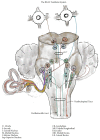Clinical Evaluation of Patients with Vestibular Dysfunction
- PMID: 30863640
- PMCID: PMC6377969
- DOI: 10.1155/2019/3931548
Clinical Evaluation of Patients with Vestibular Dysfunction
Abstract
Dizziness is a common reason for outpatient neurology consultation. Oftentimes, a complete workup by general practitioner, including MRI brain fails to reveal a cause. Some patients would have also undergone an ENT evaluation before approaching neurology for an answer. Such scenarios provide a challenge as well as opportunity for the neurologist to exercise their knowledge and clinical skills in arriving at a diagnosis. Conditions like 'Unspecified Vestibular Dysfunction' and 'Presbyvertigo' are often the underlying causes, which are either not recognized or misdiagnosed as BPPV, psychogenic or perceptive dizziness. This article's goal is to help understand vestibular system and diagnose vestibular dysfunction in clinical practice.
Figures


References
-
- Brodal A. Anatomy of the vestibular nuclei and their connections. In: Bagger-Sjöbäck D., Brodal A., Cohen B., et al., editors. Vestibular System Part 1: Basic Mechanisms. Springer Berlin Heidelberg; 1974. pp. 239–352. - DOI
Publication types
LinkOut - more resources
Full Text Sources
Research Materials
Miscellaneous

